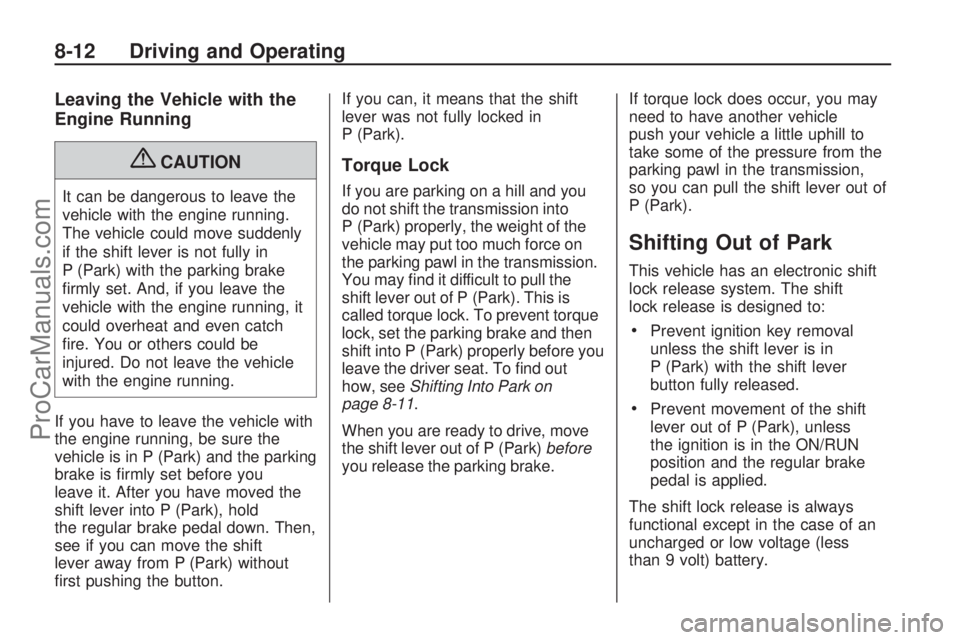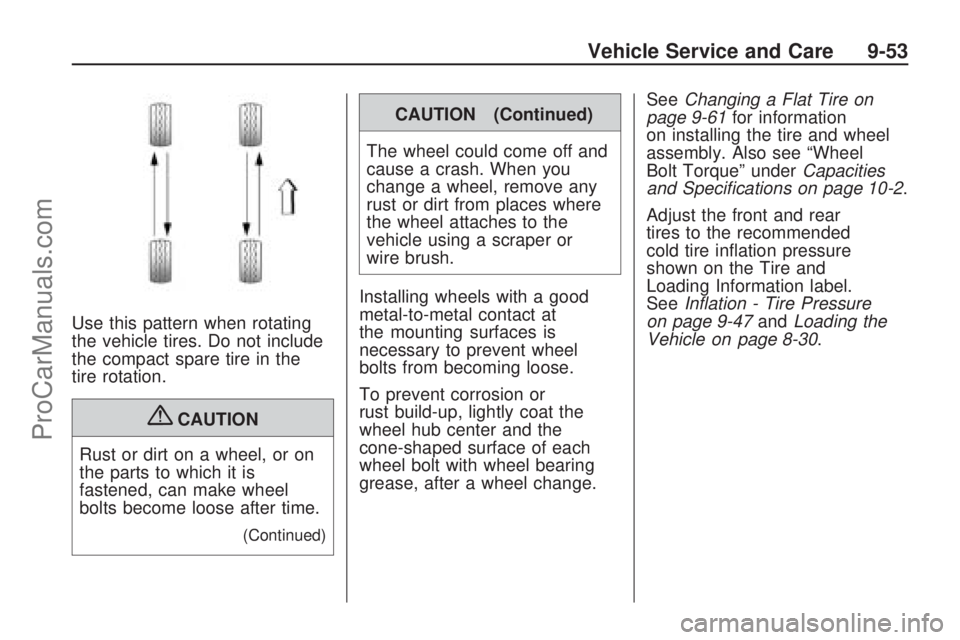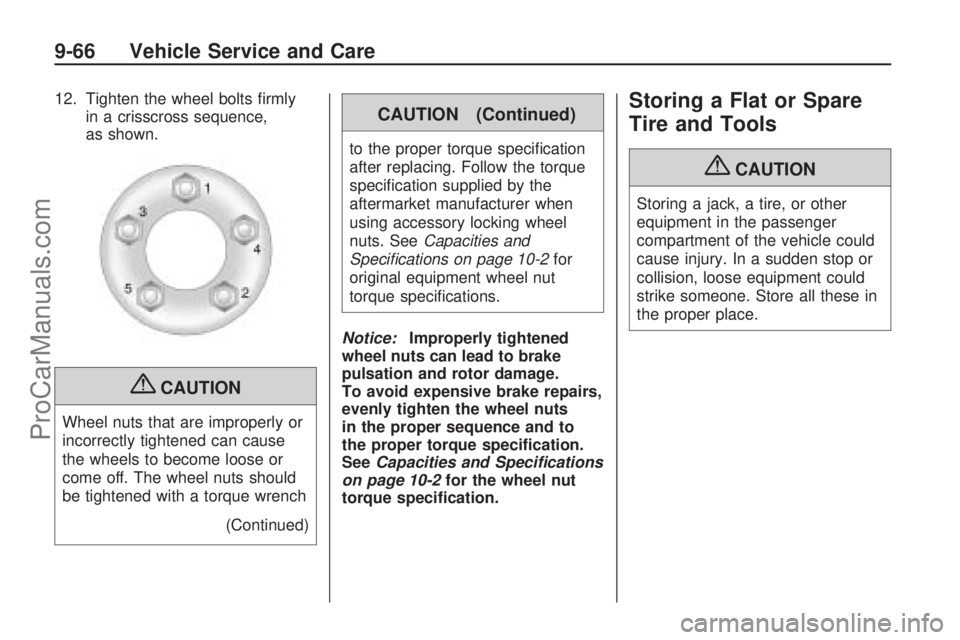torque SATURN ASTRA 2009 Owners Manual
[x] Cancel search | Manufacturer: SATURN, Model Year: 2009, Model line: ASTRA, Model: SATURN ASTRA 2009Pages: 314, PDF Size: 1.94 MB
Page 158 of 314

Leaving the Vehicle with the
Engine Running
{CAUTION
It can be dangerous to leave the
vehicle with the engine running.
The vehicle could move suddenly
if the shift lever is not fully in
P (Park) with the parking brake
�rmly set. And, if you leave the
vehicle with the engine running, it
could overheat and even catch
�re. You or others could be
injured. Do not leave the vehicle
with the engine running.
If you have to leave the vehicle with
the engine running, be sure the
vehicle is in P (Park) and the parking
brake is �rmly set before you
leave it. After you have moved the
shift lever into P (Park), hold
the regular brake pedal down. Then,
see if you can move the shift
lever away from P (Park) without
�rst pushing the button.If you can, it means that the shift
lever was not fully locked in
P (Park).
Torque Lock
If you are parking on a hill and you
do not shift the transmission into
P (Park) properly, the weight of the
vehicle may put too much force on
the parking pawl in the transmission.
You may �nd it difficult to pull the
shift lever out of P (Park). This is
called torque lock. To prevent torque
lock, set the parking brake and then
shift into P (Park) properly before you
leave the driver seat. To �nd out
how, seeShifting Into Park on
page 8-11.
When you are ready to drive, move
the shift lever out of P (Park)before
you release the parking brake.If torque lock does occur, you may
need to have another vehicle
push your vehicle a little uphill to
take some of the pressure from the
parking pawl in the transmission,
so you can pull the shift lever out of
P (Park).
Shifting Out of Park
This vehicle has an electronic shift
lock release system. The shift
lock release is designed to:
Prevent ignition key removal
unless the shift lever is in
P (Park) with the shift lever
button fully released.
Prevent movement of the shift
lever out of P (Park), unless
the ignition is in the ON/RUN
position and the regular brake
pedal is applied.
The shift lock release is always
functional except in the case of an
uncharged or low voltage (less
than 9 volt) battery.
8-12 Driving and Operating
ProCarManuals.com
Page 208 of 314

Rear disc brake pads do not have
built-in brake pad wear indicators.
Periodic visual inspection of the rear
brake pads is required to determine
when to replace the pads. Visually
inspect the rear brake pads
whenever the rear wheels are
removed such as during tire rotation.
1. Set the parking brake and make
sure that the brakes have been
given enough time to cool.
2. Remove the rear wheels.
3. Visually inspect the rear brake
inner pads (C) at each rear
wheel through the inspection
window in the brake caliper (A).Brake pads should be replaced
when the inner pad (C) is
worn to 5/64 in (2 mm) of pad
thickness (B). New brake pads,
with no wear, are 25/64 of
an inch (10 mm) thick.
4. After brake pad inspection or
replacement, install the rear
wheels.
Some driving conditions or climates
can cause a brake squeal when
the brakes are �rst applied or
lightly applied. This does not mean
something is wrong with the brakes.Properly torqued wheel bolts are
necessary to help prevent brake
pulsation. When tires are rotated,
inspect brake pads for wear
and evenly tighten wheel bolts in
the proper sequence to torque
speci�cations inCapacities
and Specifications on page 10-2.
Brake linings should always
be replaced as complete axle sets.
Brake Pedal Travel
See your dealer/retailer if the brake
pedal does not return to normal
height, or if there is a rapid increase
in pedal travel. This could be a
sign that brake service might
be required.
Brake Adjustment
Every brake stop, the disc brakes
adjust for wear.
9-24 Vehicle Service and Care
ProCarManuals.com
Page 237 of 314

Use this pattern when rotating
the vehicle tires. Do not include
the compact spare tire in the
tire rotation.
{CAUTION
Rust or dirt on a wheel, or on
the parts to which it is
fastened, can make wheel
bolts become loose after time.
(Continued)
CAUTION (Continued)
The wheel could come off and
cause a crash. When you
change a wheel, remove any
rust or dirt from places where
the wheel attaches to the
vehicle using a scraper or
wire brush.
Installing wheels with a good
metal-to-metal contact at
the mounting surfaces is
necessary to prevent wheel
bolts from becoming loose.
To prevent corrosion or
rust build-up, lightly coat the
wheel hub center and the
cone-shaped surface of each
wheel bolt with wheel bearing
grease, after a wheel change.SeeChanging a Flat Tire on
page 9-61for information
on installing the tire and wheel
assembly. Also see “Wheel
Bolt Torque” underCapacities
and Specifications on page 10-2.
Adjust the front and rear
tires to the recommended
cold tire in�ation pressure
shown on the Tire and
Loading Information label.
SeeInflation - Tire Pressure
on page 9-47andLoading the
Vehicle on page 8-30.
Vehicle Service and Care 9-53
ProCarManuals.com
Page 250 of 314

12. Tighten the wheel bolts �rmly
in a crisscross sequence,
as shown.
{CAUTION
Wheel nuts that are improperly or
incorrectly tightened can cause
the wheels to become loose or
come off. The wheel nuts should
be tightened with a torque wrench
(Continued)
CAUTION (Continued)
to the proper torque speci�cation
after replacing. Follow the torque
speci�cation supplied by the
aftermarket manufacturer when
using accessory locking wheel
nuts. SeeCapacities and
Specifications on page 10-2for
original equipment wheel nut
torque speci�cations.
Notice:Improperly tightened
wheel nuts can lead to brake
pulsation and rotor damage.
To avoid expensive brake repairs,
evenly tighten the wheel nuts
in the proper sequence and to
the proper torque speci�cation.
SeeCapacities and Specifications
on page 10-2for the wheel nut
torque speci�cation.
Storing a Flat or Spare
Tire and Tools
{CAUTION
Storing a jack, a tire, or other
equipment in the passenger
compartment of the vehicle could
cause injury. In a sudden stop or
collision, loose equipment could
strike someone. Store all these in
the proper place.
9-66 Vehicle Service and Care
ProCarManuals.com
Page 267 of 314

ApplicationCapacities
English Metric
Transmission Fluid Automatic Transmission 4.2 qt 4.0 L
Manual Transmission 1.6 qt 1.5 L
Wheel Bolt Torque 81 lb ft 110 Y
All capacities are approximate. When adding, be sure to �ll to the approximate level, as recommended in this
manual.
Engine Speci�cations
Engine VIN CodeTransmission Spark Plug Gap
1.8L L4 1Automatic
Manual 0.035 in (0.90 mm)
Technical Data 10-3
ProCarManuals.com